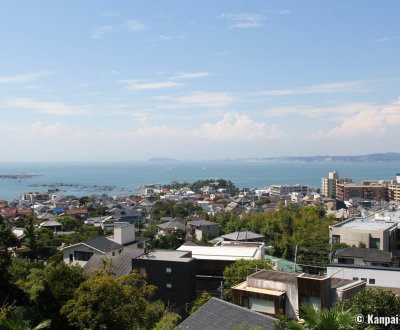Hayama
Miura’s Peaceful Coastal Village
Hayama is a small town of the Miura Peninsula, located in the south of Zushi, in Kanagawa prefecture, south to Tokyo and close to Kamakura. A holiday destination for the Imperial Household, its shrine, temple, 2 parks and Museum of Modern Art are worth the detour. Fresh sea air is blowing in this peaceful and plebeian town off the beaten tracks of mass tourism.
Hayama is neighboring Zushi, making the visit of both places on a day trip easy. These two coastal towns offer a break from larger cities, with a little bit more nature in Hayama than in Zushi.

A touch of culture on the seaside
A Museum of Modern Art has flourished in the southernmost part of Hayama, staging four to five temporary exhibitions per year, dedicated to Western as well as Japanese artists. Just next to it, Hayama Shiosai Park is a beautiful Japanese garden with a small pond, carps and perfectly trimmed trees. It is open to the public since 1987 and was formerly part of the Hayama Goyotei Imperial Residence.
A narrow path, somewhat hidden among the houses, leads to Isshiki Kaigan beach 🏖, located beneath the museum and the garden. It seems that only locals enjoy the place, so it can be interesting to have a look there and take in the atmosphere.
Hayama Goyotei, the Emperor’s summer residence, is located further south, but is not open to the public. The presence of forbidding gatekeepers at its entrance reminds that this summer house managed by the Imperial Household Agency (Kunaicho) is still frequently used by the Japanese monarch and the imperial family.

Ajisai Park and its surroundings
From Isshiki Kaigan, walk along the coast towards Hayama’s main shrine to find the small Shinnase Kaigan bay that displays a view on a tiny torii ⛩️ on a rocky levee, with the impressive Mount Fuji 🗻 appearing in the background when the weather is clear. Climbing uphill and moving away from the sea, explore the charming and pleasant small neighborhood. You can enter in the small Kotoku-ji temple, take off your shoes and enjoy the quietness of the wooden construction.
Just behind, Ajisai Park offers a nice viewpoint on the area. Its access is a narrow stairway leading to large hydrangeas plantations, that gave their name to the park. On a small plaza, a beautiful wooden table protected by the shade of a tree welcomes picnickers. The park is mainly interesting in June, when the hydrangeas bushes are in full bloom and add a touch of blue to the scenery.
To reach Morito-daimyojin shrine while avoiding the main traffic street, walk amid the large, beautiful houses, some of which designed by architects. One can imagine the locals’ lifestyle in this quiet area, a little bit withdrawn from the seaside bustling.

Morito-daimyojin shrine, in the heart of Hayama
Several red torii gates indicate the entrance of Morito-daimyojin shrine from Hayama’s main street. The place is protected by white-stone koma-inu (sculptures of animals-guardians whose appearance is somewhere between the dog and the lion). Skillfully trimmed trees and wooden lanterns 🏮 side the path to the main building, a little bit uphill.
Without realizing it, one reaches a tiny piece of land surrounded by the sea, that reminds of a landscape of Okinawa. Morito-daimyojin’s particularity compared to the usual shrine is its location on the coast, with the ema plates and paper horoscopes fluttering with the marine winds and the ocean on the background. A rocky beach hidden just behind the shrine is a welcoming place for a picnic or a bath in the sea.
On the side of the alley to the shrine, the red Misogi Bridge connects to Morito Kaigan and gives a first glimpse of it. At the time of our visit, the beach was just recovering from the large typhoon 🌀 Hagibis, but it is usually a more pleasant beach than Zushi’s.
The streets located east to the shrine and the beach have a large choice of restaurants for lunch. Among them, feel free to try Kaina, that serves a set of Japanese dishes with rice and miso soup.
Hayama’s modest size allows a few-hours visit and to stroll on the beach or relax in a cafe. It is not necessary, however, to go to the marina, as boats are inaccessible, and most are dry docked on a concrete floor without much interest. Apart from this, Hayama offers a nice breather in a coastal village that is both plebeian and attractive.

